| 1 | Caspian cobra |
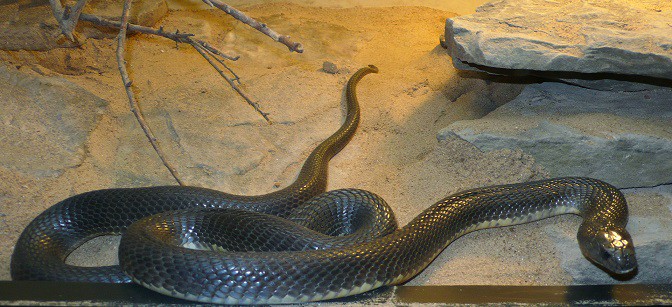
If you’re in Afghanistan and see a cloud of dust speeding down a rocky hillside, slowly growing closer to you, then there’s only one candidate: the Caspian cobra. This infamous neurotoxic cobra inhabits the dry arid areas of Pakistan, Afghanistan and northwest India. They can appear outside rickety livestock gates in villages, demanding access, but also the most remote canyons and arid hillsides strewn with boulders.
Caspian cobras are fast-moving and reach up to 1.7 metres. Virtually all their territory is arid, but they don’t stay put. As a Caspian cobra ascends one rocky hillside, there’s a good chance they’ll be climbing the next distant one the next day. Studies suggest that Naja oxiana has the most potent venom of any cobra, with a redeeming feature being that they cannot spit. The venom contains neurotoxins which trigger respiratory failure and progressive muscular paralysis, and even a toxin called Ribonuclease V1 that shreds RNA.
Unlike a rattlesnake, Caspian cobras aren’t interested in stealth. They slither down rocky slopes confidently and alertly, in full view of everyone. As far as they’re concerned, humans are no threat to them, though they may not have factored in AK-47s yet. The main time a Caspian cobra takes shelter is in dark mammal burrows to avoid the searing heat.
| 2 | Black-tailed rattlesnake |
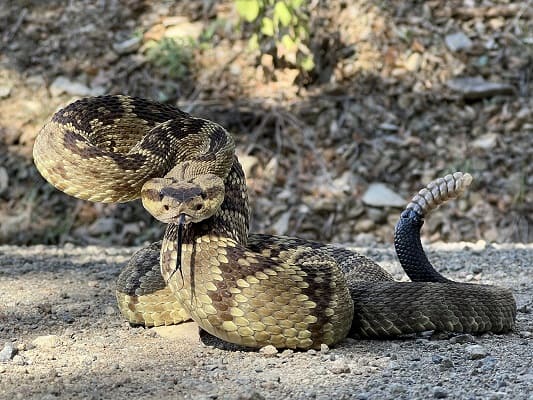
A species reaching up to 152.4cm, with moderate haemorrhagic and cytotoxic powers in rats. Black-tailed rattlesnakes can rupture capillaries in the brain by dissolving laminin and type 4 collagen, yet they have 0 confirmed human deaths to their name. This species appears in Arizona and Texas, where rocky desert slopes are easily their favourite habitat.
For example, a 1995 study compared them to tiger rattlesnakes and west diamondback rattlesnakes in the dry foothills of Tucson. The former preferred rocky slopes and desert flats, the latter desert flats with plenty of creseote bushes. Black-tailed rattlesnakes easily had the strongest correlation with rocky slopes. A study from Tonto National Monument found that they preferred especially steep rocky slopes. They use these both as hibernation sites and more casual resting places.
Crotalus molossus is easily recognisable by its namesake black tail, which only ceases at the musical rattle segments. This is a relatively non-aggressive species, sometimes allowing humans to walk past without hissing or rattling. The one advantage of haunting rocky slopes (perhaps with hiking trails through them) is that black-tailed rattlesnakes rarely appear near buildings.
| 3 | Durango mountain kingsnake |
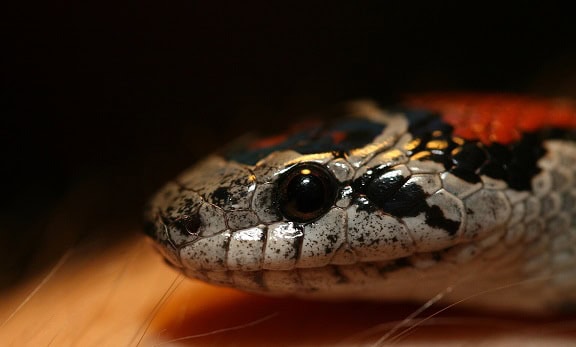
The California mountain kingsnake is a common neighbour of people and sometimes flops down beside swimming pools. The Durango mountain kingsnake is found on remote rocky wooded slopes in central Mexico, under a starry sky, far from humanity. This is a rare kingsnake and a difficult one to find, as they love to vanish into dark crevices when the weather gets too warm. They live far from any major city, in their namesake Durango mountains.
Durango mountain kingsnakes would have excellent views to enjoy, if they cared to look at them (though maybe they do). To find this species, you have to venture off the beaten track, by parking your car and climbing over boulders for 4 hours. Even then, there’s no guarantee they’ll come out to say hello. Durango mountain kingsnakes (Lampropeltis greeri) inhabit rocky slopes and especially rocky slopes within oak woodlands. They can sometimes be found basking on rock slabs, and their diet includes Sceloporus spiny lizards, probably gobbled up as they too seek warmth on rock slabs.
Durango mountain kingsnakes are especially easy to recognise if you do find them. They have an elegant silvery base overlaid with reddish blotches, each with a thick red outline. It’s possible that the silver is designed to blend with rocks.
| 4 | Ring-headed dwarf snake |
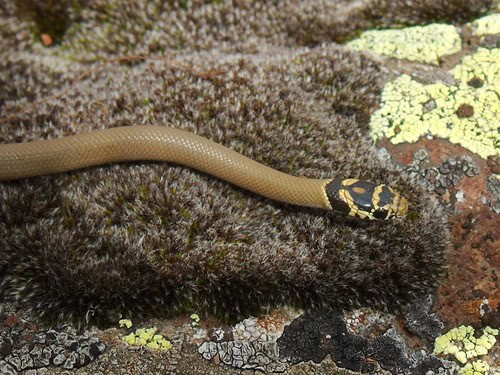
The great thing about this Turkish snake is that its habitats are well known: dry, rocky hillsides and plains. The problem is that they’re usually hidden when you get there.
Ring-headed dwarf snakes (Eirenis modestus) reach a maximum of 70cm, and lack even a mild venom. Nor do they have vicious ripping fangs. Their entire survival strategy is to flee under dark rocks as fast as possible, which also keeps them cool against the beating Turkish sun. Their small size means that you probably won’t find a loose tail poking out – they can hide every inch of their scaly bodies.
While their liking for rocky hill slopes is confirmed, as you stand on a crest and see the hills stretching for miles before you, they could literally be anywhere. The only two strategies are luck, and methodically ripping up every loose rock and stone. Eirenis modestus mainly inhabits eastern Turkey, while their diet includes grasshoppers, crickets and beetles. Potential neighbours in their rocky hillside worlds include the spotted whipsnake.
| 5 | Rubber boa |
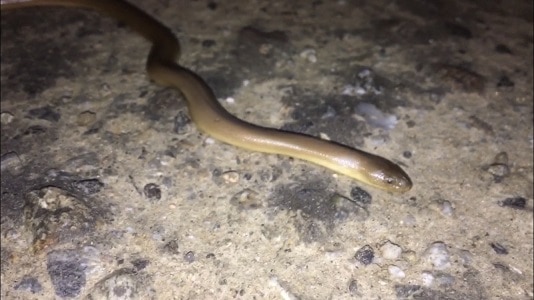
Rubber boas are found in high altitude hills of California, Oregon and Washington state. They also reach southeast Canada, making them the world’s most northerly boa. Rubber boas have a specific favorite habitat: forested hills with an abundance of grassy, rocky clearings. They have a particular tendency to hibernate in rocky slopes facing the south, to maximise sunlight on chilly winter days.
It might feel like rocky slopes are safer away from deserts, at least for snakes. But as you climb a rocky forest outcrop on a fun weekend day out, this is a snake which could poke its head out of a dark crack and send you plummeting back down again.
Luckily, you only have to hold your nerve, as rubber boas are completely harmless. They never bite, even if manhandled, and they never coil around your arm and constrict you. Walking past this worm-like snake is a complete non-factor. Rubber boas skip low altitudes in California, but can be extremely common in the forested, rocky, boulder-strewn mountain ranges. The state also hosts a far rarer species: the southern rubber boa (Charina umbratica).
| 6 | European catsnake |
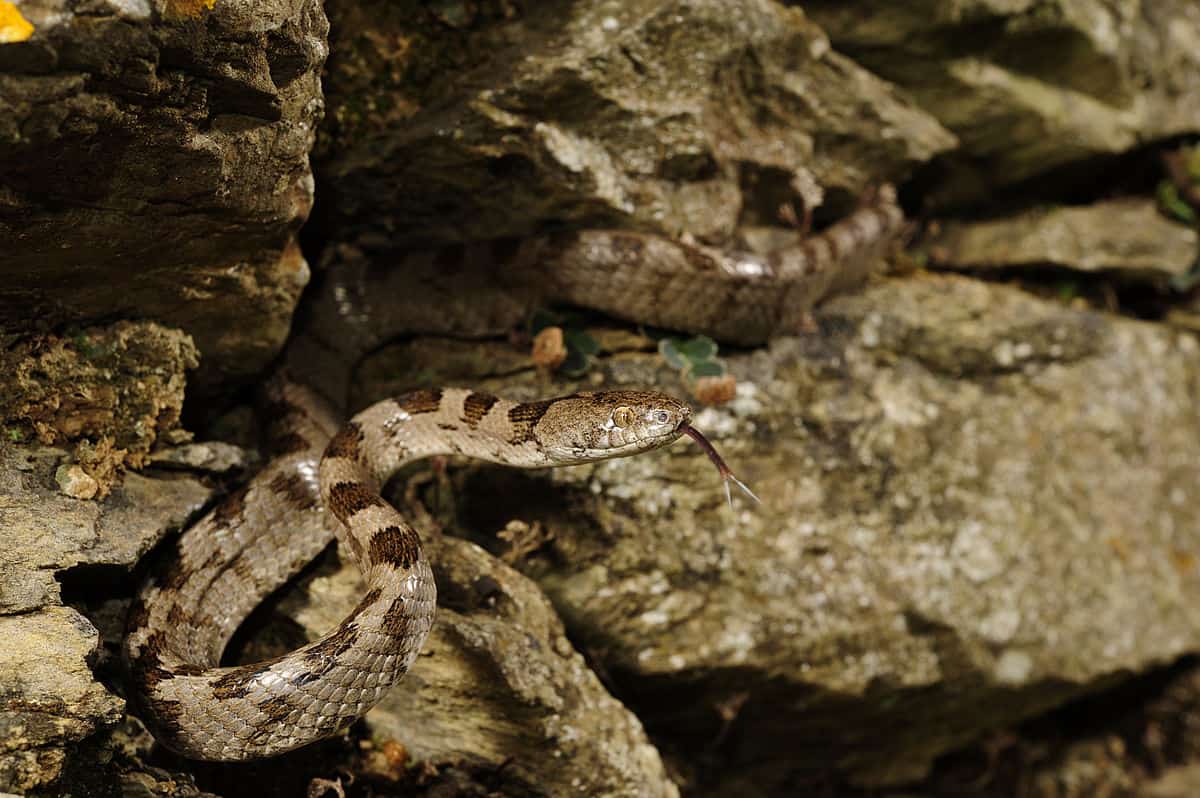
This mildly venomous snake covers virtually all of Greece, plus western Turkey. Its name derives from its vertical pupils and nocturnal habits. European catsnakes are usually found in rocky slopes, and in rocky canyons, where they can swell to huge numbers in certain spots. Here, they share terrain with another rock slope lover, the nose-horned viper, whose shades they have grown to mimic for protection.
European catsnakes live in a maze, which look like rocks to us, but probably look like boulders to them. They probably know each familiar rock inside out, remembering that it’s the one which wall lizards (their favourite prey) tend to scamper over.
European catsnakes avoid excessive temperatures and prefer to take shelter by day, when they could surprise you. This is a snake you’re likely to meet after impatiently ditching your tour guide, getting lost in a rocky canyon, then remembering why you hired a guide in the first place. If you want to meet them, European catsnakes are no threat, but do make a strange whistling noise if cornered.
| 7 | Many-horned adder |
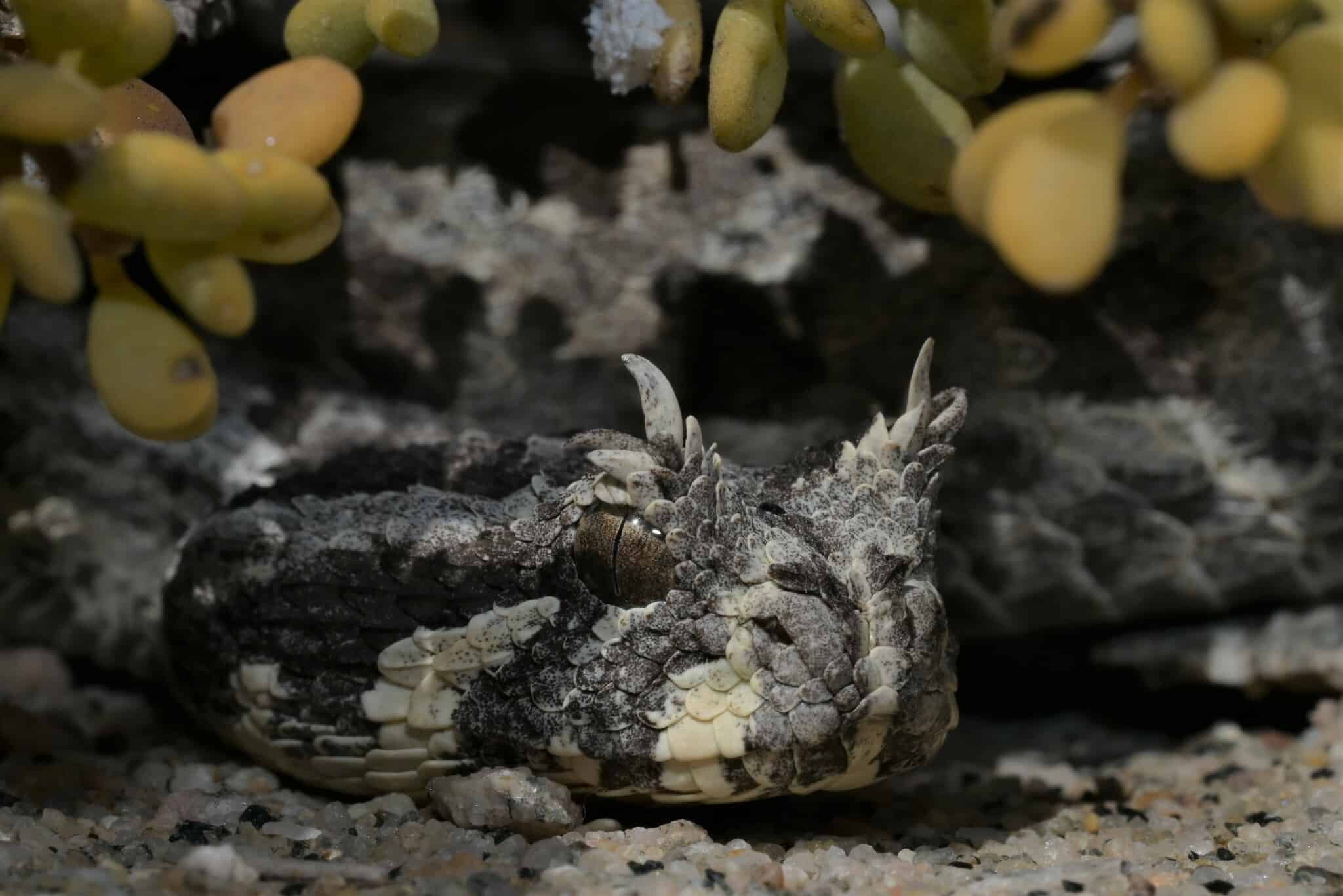
This venomous species not only lives on arid rocky slopes, but seems to be transforming into a rock. The many-horned adder (Bitis cornuta) is a short African species measuring just 30-50cm. The only thing that isn’t short is their horns, which aren’t singular, but spiraling outwards in many prongs.
This species has only a moderately toxic venom and bites are extremely rare, mainly because they live remotely. While a cousin of the rainforest-dwelling butterfly viper, Bitis cornuta only inhabits dry landscapes, in a narrow slice of southern Namibia and western South Africa. Likewise, they’re never found by woodland game trails like the infamous puff adder, which tops the tables of annual African snakebites.
Many-horned adders don’t quite inhabit sand deserts, but are one rung below. If you meet one, you’re probably in serious danger anyway, most likely stumbling through a rocky semi-desert searching for water, hoping your guide lives up to their promise and returns. Many-horned adders blend superbly into both sandy soils and rock slabs. Their camouflage is positioned just correctly to be invisible in both. Many-horned adders are nocturnal, with vertical pupils, and often coil up close to the shelter of large rocks, making them difficult to notice.
| 8 | Spotted whipsnake |
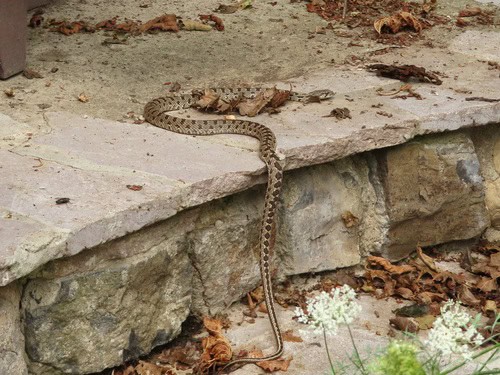
A 100cm species of eastern Turkey. This is a snake that would have watched on as Roman legions marched past 2000 years ago, trying to regain control of Armenia yet again. It would have witnessed the armies of the Ottoman empire and Persians as they dueled for supremacy, from its comfortable hillside perch. Millenia later, civilisations have come and gone, but spotted whipsnakes are still here, patrolling eastern Turkey’s rugged steppe and dry rocky hills.
This is a fast-moving species which moves effortlessly over rocks, and also moves effortlessly into rocks when it needs to shelter. Spotted whipsnakes feed on reptiles such as toad-headed agamas, and are rarely found near towns, perhaps near remote villages. While no fatalities are known, their venom can cause swelling within 15 minutes, lasting up to 72 hours.
Spotted whipsnakes are allergic to thick forests, and much prefer rocky hill slopes, even if there’s a chance they could dislodge a stone and trigger a calamitous rock slide which crushes them. They’re rarely found at below 1200 metres, and appear at up to 3600 metres in mountainous areas. This species is recognisable by dark messy blotches which converge into orderly stripes on their tail. Unlike Eirenis modestus, spotted whipsnakes slither openly through rocky plains, not bothering to hide under rocks.
| 9 | Ground snake |
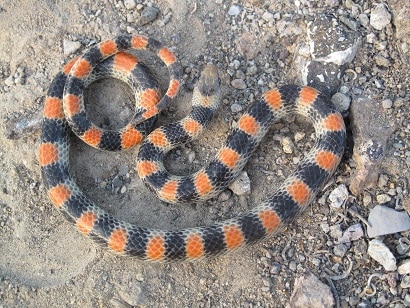
A widespread non-venomous snake found in Nevada, Arizona, California and parts of Mexico. This species measures 25-45cm, and appears on dry hillsides, arid shrubland and rocky slopes by long interstate highways. This is a likely snake to peer down at you from above as your car whooshes past on the way to Las Vegas. Ground snakes mainly prey on scorpions, spiders and centipedes.
Unlike a many-horned adder, their camouflage on rocky slopes is pretty weak. Ground snakes are one of the USA’s most variable species in colour. There’s red-black morphs, black-white, pink-yellow. The amount of morphs then quadruples, as each color combo can have a vertically striped version, a banded, a spotted, or a non-patterned. While the black-white form would blend decently, most ground snakes are very bright.
This species has several confirmed predators; this image from Arizona shows one in the clutches of a hairy tarantula. Yet ground snakes remain extremely widespread. Somehow, they must have a secret that keeps them safe in their rocky slopes, perhaps a supreme instinct for entering dark crevices, or piles of loose pebbles they can bury themselves under.
| 10 | Saw-scaled viper |
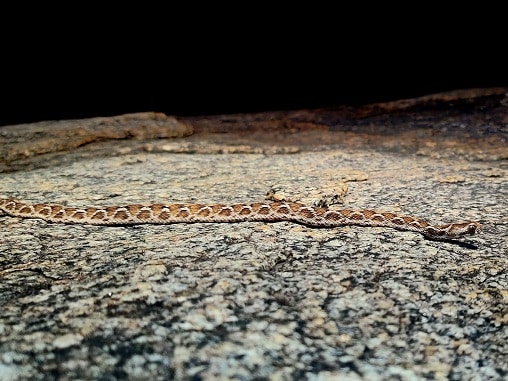
In 2021, a British stonemason had ordered a shipment of rocks from India. When he opened the crate, he was greeted by one of the world’s deadliest snakes – the saw-scaled viper. The snake was taken by South Essex Wildlife Hospital, all while hissing and spitting. The man was likely saved by cool conditions within the crate, which had suppressed the snake into a semi-comatose state.
Saw-scaled vipers cause the 2nd most annual snakebites in India after the Russell’s viper. Instead of crop fields and rice paddies, they favour dry areas such as semi-deserts and rocky slopes. By day, they hide underground in mammal burrows. By night, they hunt for scorpions and short-fingered geckos on the dry rocky terrain, and grind their scales together and make a unique sawing noise (hence the name) at anyone who strays close. A saw-scaled viper’s beige patterns are optimised to blend with a mixture of sand and rocks, and they’re occasionally found beneath piles of coconut husks.
A saw-scaled viper’s bite begins with balloon-like swelling, then progresses to uncontrollable bleeding and kidney failure. Saw-scaled vipers fare poorly on grass, losing their agility. Despite inhabiting open terrain, they’re harder to spot than you’d think. They have perfect camouflage for rocky plains, and they’re relatively immobile, thus explaining how one was scooped up in a box of rocks and shipped thousands of miles overseas.
